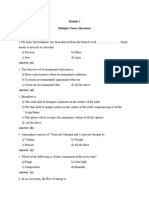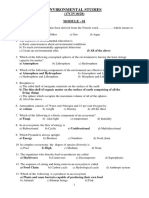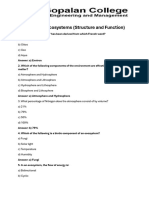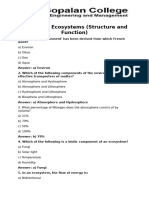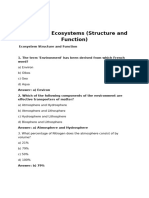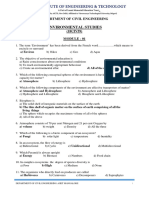0 ratings0% found this document useful (0 votes)
51 viewsEVS Assignment1
Uploaded by
sosq761Copyright
© © All Rights Reserved
We take content rights seriously. If you suspect this is your content, claim it here.
Available Formats
Download as DOCX, PDF, TXT or read online on Scribd
0 ratings0% found this document useful (0 votes)
51 viewsEVS Assignment1
Uploaded by
sosq761Copyright
© © All Rights Reserved
We take content rights seriously. If you suspect this is your content, claim it here.
Available Formats
Download as DOCX, PDF, TXT or read online on Scribd
You are on page 1/ 8
East West Institute of Technology
(Affiliated to Visvesvaraya Technological University, Belagavi)
Bengaluru-91
Department of Computer Science & Engineering
(2024-25ODD Semester)
Assignment-1 (Question Bank)
Course Name: Environmental Studies and E-Waste Management Semester: V CS1,CS2,CS3
Course Code:BCS508 Assignment: 1
Course Outcomes: After studying this course, students will be able to:
BCS508.1 Identify the major challenges of environmental issues
BCS508.2 Apply the concepts of computer networks to demonstrate the working of various layers and
protocols in communication network.
BCS508.3 Analyze the principles of protocol layering in modern communication systems.
Module-1 – Ecosystem & Sustainability
1. The term ‘Environment’ has been derived from the French word which
means
to encircle or surround
a) Environ b) Oikos c) geo d) Aqua
2. Which of the following conceptual spheres of the environment is having the least storage
capacity for matter?
a) Atmosphere b) Lithosphere c) Hydrosphere d) Biosphere
3. Which of the following components of the environment are effective transporters of matter?
a) Atmosphere and Hydrosphere b) Atmosphere and Lithosphere
c) Hydrosphere and Lithosphere d) Biosphere and Lithosphere
4. Biosphere is
a) The solid shell of inorganic materials on the surface of the earth
b) The thin shell of organic matter on the surface of earth comprising of all the living things
c) the sphere which occupies the maximum volume of all of the spheres
d) all of the above
5. Atmosphere consists of 79 per cent Nitrogen and 21 per cent Oxygen by
a) volume b) weight c) Density d) All the three
6. Which of the following is a biotic component of an ecosystem?
a) Fungi b) solar light c) temperature d) humidity
7. In an ecosystem, the flow of energy is
a) Bidirectional b) Cyclic c) Unidirectional d) Multidirectional
8. Which Pyramid is always upright
a) energy b) biomass c) numbers d) food chain
9. In complex ecosystems the degree of species diversity is
a) poor b) high c) medium d)none
10. The organisms who directly feed on producers are called
a) Herbivores b) Carnivores c) Decomposers d) Saprophytes
11. The sequence of eating and being eaten in an ecosystem is called
a) Food Chain b) carbon cycle c) hydrological cycle d) anthroposystem
12. Which of the following is a producer in an ecosystem
a) Plants and some bacteria capable of producing their own food
b) Animals c) Human beings d) Fish
13. Which of the following statements is false?
a) Inorganic nutrients are recycled in an ecosystem
b) Energy ‘flows’ through the ecosystem in the form of carbon-carbon bonds
c) Energy is recycled in an ecosystem
d) Respiration process releases energy
14. The largest reservoir of nitrogen in our planet is
a) Oceans b) Atmosphere c) biosphere d) Fossil fuels
15. In aquatic ecosystem phytoplankton can be considered as a
a) Consumer b) producer c) Saprotrophic organisms d)Macroconsumer
16. The basic requirements of human beings are provided by
a) Industrialization b) Agriculture c) Nature d) Urbanization
17. Environment is the life support system that includes
a) Air b) Water c) Land d) All of the above
18. In an ecosystem biological cycling of materials is maintained by
a) Producer b) Consumer c) Decomposer d) All of the above
19. Organisms which feed directly or indirectly on producers are called
a) Prey b) Consumers c) Decomposers d) Detritus\
20. The primary producers in a forest ecosystem are
a) Chlorophyll containing trees and plants b) Herbivores
c) Carnivores d) Bacteria and other microorganisms
21. Abiotic component includes
a) Soil b) Temperature c) Water d) All of the above
22. Which of the following statement is true
a) Green plants are self nourishing b) Producers depends on consumers
c) Biotic components includes all non-living components
d) Herbivores depend on Carnivores
23. Primary consumer is
a) Herbivores b) Carnivores c) Macro consumers d) Omnivores
24. A predator is
a) An animal that is fed upon b) An animal that feeds upon
another animal
c) Animal that feeds upon both plants and animals d) a primary consumer
25. The word ‘Environment’ is derived from
a) Greek b) French c) Spanish d) English
26. Which among the following is a climatic factor?
a) Pressure b) humidity c) temperature d) all of the above
27. Which of the following is the terrestrial ecosystem?
a) Forest b) Grass land c) Desert d) All of the above
28. World Environment day is on
a) 5th May b) 5th June c) 18th July d) 16th August
29. Factors responsible for balanced ecosystem are
a) Balance between predator and prey
b) Balance between vegetation, herbivorous and carnivorous
c) Balance between competing species and biotic factors
d) All of the above
30. Which of the following is absorbed by green plants from the atmosphere?
a) Carbon dioxide b) Water c) Nutrients d) All of above
31. Habitat refers to
a) Physical conditions of the place where organisms live
b) Chemical conditions of the place where organisms live
c) Both a & b d) None of a or b
32. A food web consists of
a) a portion of a food chain b) an organism’s position in a food chain
c) interlocking food chains d) a set of similar consumers
33. Which of the fallowing are producers’
a) Animals b) Human being c) Plants & Bacteria d) Fishes
34. Which of the fallowing is a ecosystem.
a) Forest b) desert c) Mountain d) All.
35. Environment means
a) Surrounding (Biotic + Abiotic components), in which organisms live.
b) Atmosphere around one self.
c) Sum total of social, Economical, biological behavior of animals.
d) Sum total of development activities around.
36. Which of the fallowing is not the meaning of ecosystem?
a) Unit where in all organisms live a healthy life.
b) a small unit that can be self sufficient.
c) Co-Existence of diverse things by mutual adjustment.
d) A unit includes all of the organisms in a given area interacting with the physical
environment to form a natural unit of stability.
37. Which of it is not an example for an terrestrial ecosystem.
a) Forest b) Desert c) Water d) Grassland.
38. The factor responsible for stable ecosystem are balance between.
a) Predators & Pray b) Vegetation, Herbivores & carnivores.
c) Competing species & Biotic factor d) All the above.
39. Important physical factor responsible for a good habitat of a organism.
a) Light b) Temperature c) Humidity d) All the above
40. Which of the fallowing is not a prominent chemical responsible for a good habitat.
a) O2 b) CO2 c) SO2 d) Nutrients
41. --------is termed as the life zone of the earth.
a) Atmosphere b) Hydrosphere c) Biosphere d) Stratosphere.
42. An ecosystem is a region in which
a) Dead organism interact with their environment
b) Living organism do not interact with their environment
c) Living organism interact with their environment
d) All the above.
43 The term ecosystem was first proposed by
a) Jacob van verkul b) A G Transley c) Costraza d) Marie Gibbs.
44. The two major components of ecosystem are
a) Adiabatic & Isotropic b) Ecologic & climatologic
c) Cyclic & biologic d) Abiotic & biotic.
45. Biotic components includes
a) All living organisms b) water, mineral & gases
c) Self-nourishing green plants d) Light, temperature etc.
46. Food chain is divided into ---------basic categories
a) Four b) Three c) Five d) seven
47. The transfer of energy & nutrients from one feeding group of organization to another
in a series is called.
a) Energy chain b) Food Chain c) Balanced ecosystem d) Food Web
48. In which of the following place we can find the cold deserts?
a) Bangalore b) Chennai c) Himalaya d) Rajasthan
49. What kind of climate we can find in the Thar Desert?
a) Cold b) Dry c) Cool d) Moist
50. Where can we find babul tree?
a) In deserts ecosystems b) In river deltas c) In grassland ecosystems d) In semi-arid ecosystems
51. Why Rann of Kutch attracts aquatic birds in monsoon season?
a) Because desert land is converted to forest land
b) Because desert land is converted to snow
c) Because desert land do not convert
d) Because desert land is converted to salt marshes
52. What makes desert region to become highly unproductive?
a) Salinity b) Sunlight c) Temperature d) Increase in the rain
53. How can desert ecosystems be conserved?
a) By minimizing the human activity b) By pouring water to desert area
c) By deforestation d) By killing organisms
54. Which of the following tribe protected trees from several generations in Rajasthan?
a) Bishnoi b) Papadi c) Korvanji d) Gudus
55. Where can we see Indira Gandhi Canal?
a) Gujarat b) Rajasthan c) Punjab d) Haryana
56. Which kind of soil we can found on the surface of Thar desert?
a) Rocky b) Moist c) Fertile d) Aeolian
57. Which is the biggest desert in the world including both hot and cold deserts?
a) Sahara b) Arctic c) Arabian d) Antarctica
58. How many parts are there in the forest ecosystem?
a) One b) Two c) Three d) Four
59. On which factor forest type is mainly dependent?
a) Abiotic b) Size of the forest c) Shape of trees d) Products from the trees
60. Where can we find coniferous forest in India?
a) Deserts b) River deltas c) Grassland d) Himalayan
61. Why most of the Sun light does not penetrate to the ground in evergreen forest?
a) Because of snowfall b) Because of less temperature c) Because of trees overlap
d) Because of less rainfall
62. Which state in India has the maximum percentage of its area covered by forests?
a) Arunachal Pradesh b) Madhya Pradesh c) Mizoram d) Nagaland
63. Where can we find thorn forest in India?
a) Semi-arid regions b) Desert regions c) Himalayan regions d) Northeast
64. How forests increase the atmosphere’s humidity?
a) By transpiration b) By inspiration c) By expiration d) By oxidation
65. Which of the following type of forest important for watersheds?
a) Tropical Evergreen forest b) Tropical Deciduous forest c) Tropical Montana forests
d) Grassland forest
66. How the tropical rain forest gets the name?
a) Due to less rain b) Due to heavy rain c) Due to moderate rain d) Due to no rain required
67. How many types of aquatic ecosystems are there?
a) One b) Two c) Three d) Four
68. Where plants and animals live in aquatic ecosystems?
a) Water b) Land c) Air d) Fire
69. What made organisms to build their ecosystem in aquatic?
a) Curiosity b) Evolution c) Force from other organisms d) Increase in water level
70. Where can we find both running water as well as stagnant water?
a) Marine ecosystems b) Wetlands c) Coral reefs d) Freshwater ecosystems
71. Which is the largest ecosystem on Earth?
a) Desert b) Forest c) Grassland d) Oceans
72. Which of the following is among the world’s most productive ecosystems in
terms of biomass production?
a) Pond ecosystems b) Lake ecosystems c) Brackish water ecosystems d) River ecosystems
73. Which is the simplest aquatic ecosystem?
a) Pond b) Stream c) Lake d) Marine
74. Which ecosystem is known as giant permanent pond?
a) Lake Ecosystem b) Pond ecosystem c) Seashore ecosystem d) Marine ecosystem
75. How many oceans constitute the marine ecosystems around peninsular India?
a) One b) Two c) Three d) Four
76.. What is the cause of discoloration in fresh water?
a) Fungal bloom b) Viral bloom c) An algae bloom d) Bacterial bloom
77. In which forest we can see deforestation to large extent?
a) Atlantic forest b) Amazon forest c) Borneo forest d) Sumatra forest
78. The biggest driver of deforestation is
a) Agriculture b) Forest fire c) Volcanic activities d) Soil erosion
79. The best way to reduce deforestation is by
a) Using more paper b) Clear more area of trees to grow plant
c) Burning forest in order to create cultivated land d) Clear more area of plants to grow trees
80. Rain forest land is most often cleared for
a) Pasture b) Forest fire c) Human activities d) High pressure
81. The main cause of wildfire is
a) Volcanic activity b) Lightening c) Pollution d) Human activity
82. Which nation is most affected by deforestation?
a) Honduras b) Indonesiac) Benin d) Ghana
83. Which type of farming cause more amount of deforestation?
a) Subsistence farming b) Commercial farming c) Mixed farming d) Dairy farming
84. Which of the following options is correct when we only accomplish two out of three pillars
of sustainable development?
A) Economic + Environmental sustainability = Viable
B) Social + Environmental sustainability = Bearable
C) Social + Economic sustainability = Equitable
D) All of the above
85. In which year did the word ‘sustainable development’ come into existence?
A) 1992 B) 1978 C) 1980 D) 1987
86.In which year was the United Nations Commission on Sustainable Development (CSD)
started by the UN General Assembly?
A) 1995 B) 1994 C) 1993 D) 1992
86. What is the definition of sustainable development?
A)The growth that satisfies current demands without jeopardising future generations’ ability to
fulfil their own needs.
B)Conserve mineral wealth and explore alternative energy sources while decreasing pollution
and environmental impact.
C)It is the process of creating land and building projects in such a way that they have a lower
environmental effect by enabling them to produce fuel-efficient self-sufficiency patterns.
D)All the preceding
87. What are all the main sustainability objectives?
I. Poverty and hunger eradication
II. Higher education and healthcare standards, notably in terms of water quality and sanitation.
III. Gender equality
IV. Long-term economic growth that promotes employment and strengthens communities
A)I, II & III B) I, III & IV C) I & III D) I, II, III & IV
88. In December———-, the General Assembly created the United Nations Council on
Environmental Sustainability (CSD).
A)1992; B)1993; C)1994; D)1995;
89. The 21st-century notion of sustainable growth places a greater emphasis on
A) Economic progress B)Social progress C)Protection of the environment D)All of the
preceding.
90. Sustainability Science is the application of concepts such as ____________ and sustainable
development.
A)Environmental science B)Science in general C)Social science D)Geoscience
91.The United Nations has established a total Sustainable Development Goals (SDGs)
A)15 B)16 C)17 D)18
92. What is the definition of Education for Sustainable Development (ESD)?
A) Teaching about environmental conservation B) Promoting a sustainable future through
education C) Focusing on economic development D) None of the above
93. What are the three pillars of sustainability?
A) Social, environmental, and economic B) Environmental, cultural, and technological
C) Economic, political, and cultural D) None of the above
94. Which of the following is a key principle of ESD?
A) Encouraging competition B) Focusing only on environmental issues
C) Promoting critical thinking D) Ignoring social and economic issues
95.What is the role of educators in promoting ESD?
A) To provide information about environmental issues
B) To promote critical thinking and problem-solving skills
C) To encourage sustainable behavior D) All of the above
D) All of the above
96.Which of the following is a challenge to implementing ESD?
A) Resistance to change B) Lack of resources C) Difficulty in measuring outcomes
D) All of the above
97. What is the purpose of the United Nations Decade of Education for Sustainable Development
(2005-2014)?
A) To promote ESD worldwide B) To provide funding for ESD projects
C) To mandate ESD in all schools D) None of the above
98.What is the relationship between ESD and social justice?
A) They are unrelated B) ESD can promote social justice
C) ESD can lead to social injustice D) None of the above
99. Which of the following is an example of a sustainable behavior?
A) Using plastic bags B) Driving a car alone C) Turning off lights when leaving a room
D) None of the above
100.Which of the following is an example of a sustainability issue?
A) Pollution B) Overfishing C) Climate change D) All of the above
101. What is the triple bottom line?
A) An accounting framework for sustainability B) A social media platform for sustainability
C) A measure of carbon emissions D) None of the above
102.What is the role of governments in promoting ESD?
A) To mandate ESD in all schools B) To provide funding for ESD projects
C) To create policies that promote sustainable behavior D) All of the above
103. What is the relationship between ESD and the Sustainable Development Goals (SDGs)?
A) They are unrelated B) ESD can help achieve the SDGs C) The SDGs are a replacement for
ESD D) None of the above
104.Which of the following is an example of a sustainable community?
A) A community that uses renewable energy
B) A community that has a high level of car ownership
C) A community that produces a lot of waste D) None of the above
105.Which of the following is not a pillar of sustainable development?
A) Economic sustainability B) Environmental sustainability
C) Social sustainability D) Technological sustainability
106. What is the primary goal of ESD?
A) To teach students about environmental issues
B) To promote sustainable practices and behaviors
C) To encourage critical thinking and problem-solving skills
D) All of the above
107.What is the role of businesses in promoting ESD?
A) To prioritize profits over sustainability
B) To engage in sustainable practices and behaviors
C) To ignore sustainability altogether
D) None of the above
108.Which of the following is an example of a sustainable city?
A) A city with high levels of pollution
B) A city with a well-developed public transportation system
C) A city with high levels of energy consumption
D) None of the above
You might also like
- Growing With The Garden: A Curriculum For Practicing Horticulture With Incarcerated IndividualsNo ratings yetGrowing With The Garden: A Curriculum For Practicing Horticulture With Incarcerated Individuals179 pages
- Environment Management and Human RightsNo ratings yetEnvironment Management and Human Rights16 pages
- Unit 1: Government Engineering College KarwarNo ratings yetUnit 1: Government Engineering College Karwar43 pages
- Module 1 - Part A Ecosystems (Structure and Function) : Forest, Desert, Wetlands, Riverine, Oceanic and LakeNo ratings yetModule 1 - Part A Ecosystems (Structure and Function) : Forest, Desert, Wetlands, Riverine, Oceanic and Lake10 pages
- Environmental Studies (Evs301S & Evs401S)No ratings yetEnvironmental Studies (Evs301S & Evs401S)19 pages
- O Level Biology Practice Questions And Answers: Ecology And Our Impact On The EcosystemFrom EverandO Level Biology Practice Questions And Answers: Ecology And Our Impact On The EcosystemNo ratings yet
- BIO150 Ecology (Lecture) Study Guide 1st Semester AY 2020-2021 WEEK 1 (Estimated Time-On-Task: 2-4 Hours) I. Overview of EcologyNo ratings yetBIO150 Ecology (Lecture) Study Guide 1st Semester AY 2020-2021 WEEK 1 (Estimated Time-On-Task: 2-4 Hours) I. Overview of Ecology19 pages
- Human Activities That Endanger An EcosystemNo ratings yetHuman Activities That Endanger An Ecosystem3 pages
- Monitoring ecological change 2ed Edition Spellerberg I.F. 2024 scribd download100% (9)Monitoring ecological change 2ed Edition Spellerberg I.F. 2024 scribd download81 pages
- Integrated Assessment of Land Use and Cover Changes in The Malagarasi River Catchment in Tanzania100% (1)Integrated Assessment of Land Use and Cover Changes in The Malagarasi River Catchment in Tanzania12 pages
- The Practice of Green Social Work in The Context of Protected Areas in The Philippines: Input For Curriculum DevelopmentNo ratings yetThe Practice of Green Social Work in The Context of Protected Areas in The Philippines: Input For Curriculum Development8 pages
- Instant Ebooks Textbook (Ebook PDF) Exploring Physical Geography 3rd Edition Download All Chapters100% (1)Instant Ebooks Textbook (Ebook PDF) Exploring Physical Geography 3rd Edition Download All Chapters49 pages
- 6. THPT Lấp Vò 2_Đề thi TN THPT 2025No ratings yet6. THPT Lấp Vò 2_Đề thi TN THPT 20256 pages
- Andrew Et Al 2014. Potential Contributions of Remote Sensing To Ecosystem Service AssessmentsNo ratings yetAndrew Et Al 2014. Potential Contributions of Remote Sensing To Ecosystem Service Assessments27 pages
- Syllabus in NSCI 111 1st Sem August 2024FRNo ratings yetSyllabus in NSCI 111 1st Sem August 2024FR19 pages
- Evaluation of Geospatial Climatic Variation and Aridity Trend of The Jigawa State, NigeriaNo ratings yetEvaluation of Geospatial Climatic Variation and Aridity Trend of The Jigawa State, Nigeria10 pages














